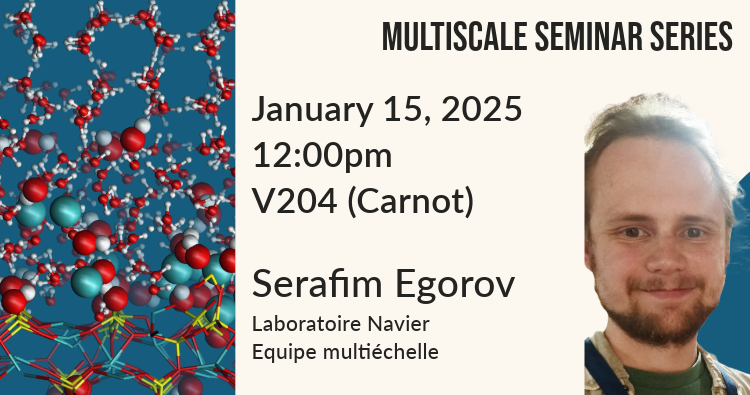
Séminaire Multiéchelle : Serafim Egorov (Navier – Multiéchelle)
Bridging variational and perturbation approaches in brittle fracture: application to shear crack in heterogeneous media
Serafim Egorov, Antoine Sanner, Jean Sulem, Lars Pastewka, Mathias Lebihain
Abstract:
In the presence of heterogeneities, crack propagation in brittle materials has been shown to be highly intermittent and to display multi-scale behavior, spanning from the heterogeneity size up to the size of the structure (Bonamy and Bouchaud, Phys. Rep., 2011). The numerical modeling of fracture processes is usually conducted using XFEM (Moës et al., IJNME, 1999) or the phase-field method (Bourdin et al., J. Elast., 2008). Both methods effectively address a wide range of scientific problems; however, these methods are computationally intensive, making 3D simulations of composites with numerous heterogeneities impractical without high-performance computing.
To model the coplanar propagation of a sharp crack, we propose to bridge the variational approach of Francfort and Marigo (JMPS, 1998) and the perturbation theory of Rice (J. Appl. Mech., 1985) and Gao (IJSS, 1988), that allow us to model the 3D fracture process from the meshing of the sole 1D crack front within a unified energetic framework. Unlike previous approaches based on the resolution of Griffith’s criterion, equilibrium positions of the crack front are computed by minimizing the sum of the potential energy of the system, which relates to the crack geometry, and the dissipated energy, determined by the (heterogeneous) fracture energy field. To address minimization, we implemented a bounded Newton conjugate gradient method with matrix-free implementation and trust region, using PETSc and JAX packages for Python.
Using our newly developed method, we have conducted 36,000 large-scale simulations of shear crack propagation in several weeks. The largest simulation has been performed on a field with high fracture energy contrast, with a seed crack starting below the heterogeneity scale and extending over three orders of magnitude with a time stepping corresponding to the crack propagation along 1/100 of heterogeneity. We demonstrate how modes II+III coupling affects front deformations and apparent fracture energy, depending on heterogeneity properties and Poisson’s ratio. Simulations reveal material weakening or strengthening based on disorder intensity and crack size: small heterogeneity contrasts weaken the material, while larger disorder intensities strengthen it, possibly due to front instabilities during crack propagation at higher disorder intensities and larger crack sizes.
Short bio:
Hello to everyone reading my bio! I began my PhD in October 2023 at Laboratoire Navier. Before this, I earned a B.Sc. and M.Sc. in Applied Mechanics from SPbPU in Saint Petersburg, as well as an M.Sc. and (soon-to-be-defended) engineering degree in Mechanical Engineering and Materials Science from ENPC in Champs-sur-Marne. My PhD research focuses on developing novel theoretical and numerical methods to describe the propagation of frictional ruptures along a single fault, employing perturbation and variational approaches within the framework of Linear Elastic Fracture Mechanics.

